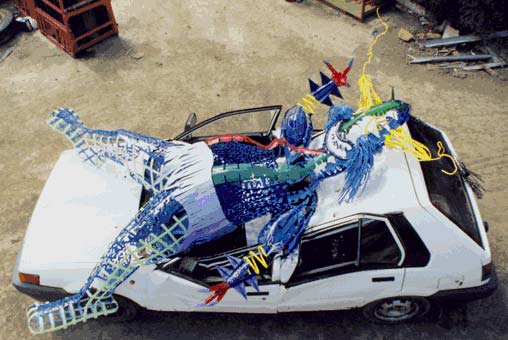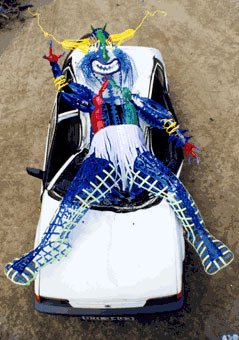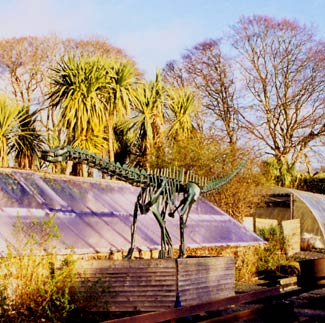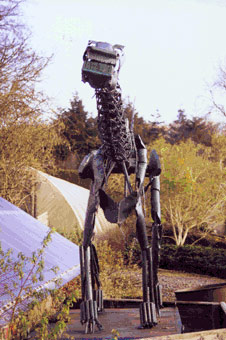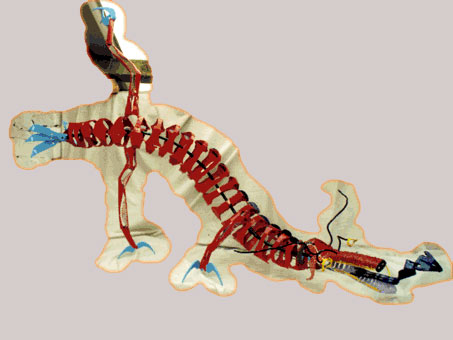|
ARTIST'S
STATEMENT
I develop sculptures from my imagination, the process
of creation and found objects; allowing the work to evolve and spread
into its own environment. I enjoy making beautiful forms out of
scrap and found objects that other people have stopped using or
don't need. This is what my work is about, pure, simple creative
forms that dominate their environment.
I am based in the South East part of Northern Ireland.
I was educated at the Surrey Institute of Art and Design, studying
Three Dimensional Design for one year, then Fine Art Sculpture for
two years. My first interest in metal came from working in my father's
scrap yard. I was always interested in creative metal work and was
astonished at all the scrap metal lying around the yard; the term
'one man's junk is another man's ‘treasure' had a strong meaning
for me.
The scrap yard was full of cars, lorries and old farm machinery,
items that people had thrown out. So I decided to salvage some of
the scrap metal and recycle the material into sculptures. Because
of my environment, where I saw scrap metal every day, it's only
natural that it would get into my imagination and my subconscious.
One of the first scrap metal creatures I made was Dip; followed
by Dragon Spirit. After that I started my studies in England for
three years. In the Degree my work changed, it became weighed down
by heavy deep visual languages; the lecturers pushed the idea that
you must know every aspect of your work, theoretical and practical.
I had a problem with that from day one.
After my studies, I travelled to Australia and New Zealand, drawing
on inspiration from my travels, putting together and collecting
images and ideas for my work. I'm interested in the way different
cultures can influence my work: for instance, the 'imbrace' piece
has its roots in New Zealand where I spent a bit of time travelling
around. Now that I have settled back in N. Ireland for the past
year and half, the freedom I had in my work when I was seventeen
and eighteen years old has come back. It's great to work without
the need to explain my work and the hassle of a heavy visual language.
You can see a steady development in my work from the first few;
Dip and Dragon Spirit to my most recent work OXI 3463 and Imbrace.
My visual language is simple and pure. I'm not sure that my work
has some deep meaning behind it; nor is it in line with the contemporary
scene in London, New York or Sydney. Imaginative, fun, funky, individual
and strong in my view best describes my work. My work makes no intellectual
requirements on the spectator, but simply presents the creative
process. It rejects the mandate that artists must define precisely
what their work is about, or base their work on some theory or other.
It's not that I've forgotten my college training, but I want to
find my own visual language that is not shaped by trends in the
art market. Nor am I turning my back on the contemporary art world,
but I want to explore pure creativeness without visual language
rules attached to it - making art outside the mainstream art world.
The exhibition in The Market Place Armagh N. Ireland in autumn 2002
was my first solo show. It was a continuously growing and evolving
experience with more sculptures added to the space during public
workshops held in the gallery on Saturday 14th September. I worked
in collaboration with the public, asking the local community to
generate ideas, drawing on the rich local history and traditions
of the area as the source or theme for the start of the workshops
and I used my own sculptural style to bring those ideas together.
Building on the community's existing skills and interest, beginning
with found objects as the basic medium for the work, participants
had a personal connection to their work. The objects were recycled
into imaginative creative creatures: the end result being an exhibition
combining the work of the community and the artist, both benefiting
from the experience of the other.
(This text is from Artesian Magazine No 5, p21, 2003)
|

